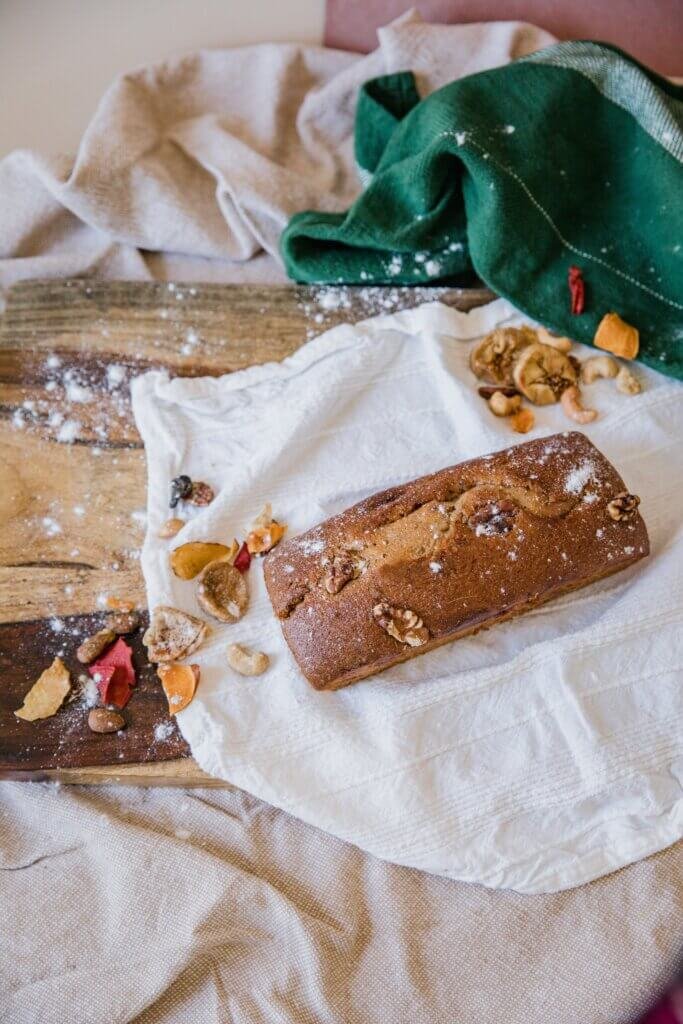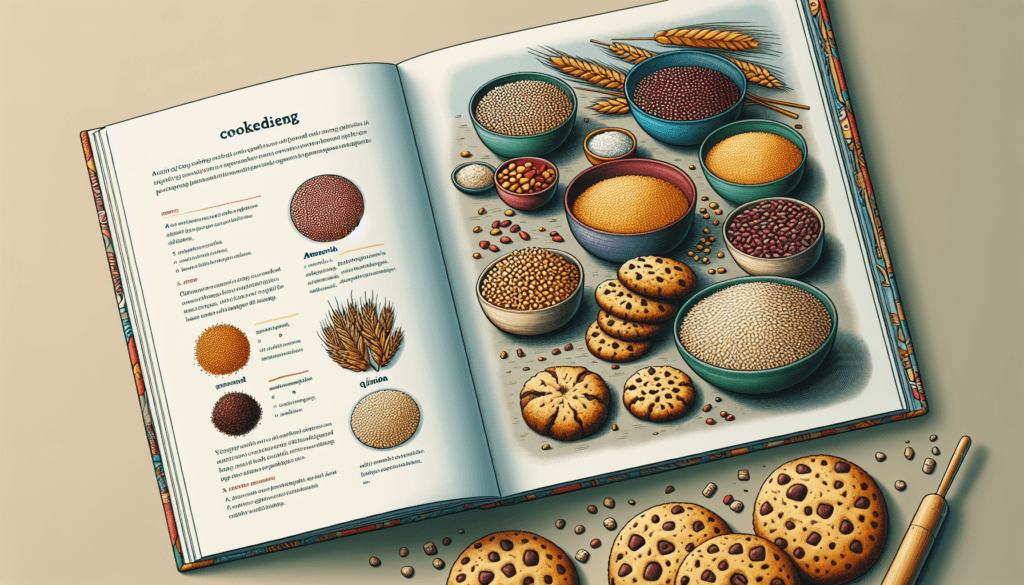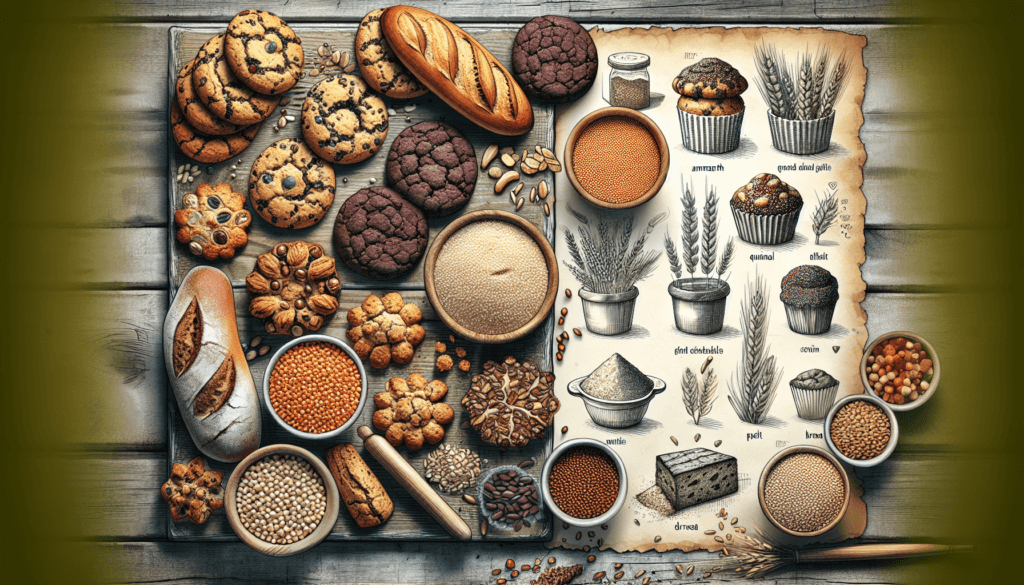Are you looking to amp up the health benefits of your baked goods? Look no further than the ultimate guide to baking with ancient grains for nutritious treats. Ancient grains like quinoa, teff, and amaranth have been cultivated and consumed for centuries, offering a wide array of vitamins, minerals, and fiber. In this comprehensive guide, you will discover the secrets to incorporating these ancient grains into your favorite baked treats, while still achieving moist and delicious results. Get ready to add a nutritious twist to your baking adventures and delight your taste buds with these wholesome ancient grain treats.

What are Ancient Grains?
Definition of Ancient Grains
Ancient grains refer to a group of grains that have remained largely unchanged for centuries, making them a true testament to the ancient civilizations that cultivated them. These grains have stood the test of time and offer a unique alternative to modern grains. They include varieties such as quinoa, amaranth, teff, millet, spelt, and farro, to name just a few. Each ancient grain has its own distinct flavor, texture, and nutritional profile, making them versatile and exciting options for baking.
Examples of Ancient Grains
There are several types of ancient grains that have gained popularity in recent years. Quinoa, for example, is a complete protein and a great source of fiber, making it a nutritious choice for baking. Amaranth is packed with vitamins and minerals, including iron and calcium, and has a sweet, nutty flavor that adds depth to baked goods. Teff, a tiny grain native to Ethiopia, is high in protein and rich in calcium, making it an excellent choice for those following a gluten-free diet. These examples are just a glimpse into the world of ancient grains and the endless possibilities they offer.
Benefits of Baking with Ancient Grains
Increased Nutritional Value
One of the most significant benefits of baking with ancient grains is their superior nutritional value compared to refined grains. Ancient grains are often minimally processed, which means they retain more of their original nutrients. They are excellent sources of fiber, minerals, and vitamins, and can provide essential nutrients like iron, magnesium, and B vitamins. Baking with ancient grains allows you to enjoy delicious treats while nourishing your body with wholesome ingredients.
Rich in Fiber
Fiber is an essential component for a healthy digestive system, and ancient grains are packed with it. Compared to refined grains, ancient grains contain more fiber, which aids in digestion, prevents constipation, and helps maintain a healthy weight. Additionally, the high fiber content of ancient grains can help regulate blood sugar levels and lower the risk of developing chronic diseases such as heart disease and diabetes. Incorporating ancient grains into your baking recipes is a wonderful way to increase your fiber intake while indulging in your favorite treats.
Gluten-Free Options
For those with gluten sensitivities or celiac disease, finding suitable alternatives for baking can be a challenge. Ancient grains come to the rescue with their gluten-free options, such as quinoa, amaranth, and teff. These grains provide an excellent substitute for wheat flour, allowing individuals with gluten sensitivities to enjoy a wide array of baked goods without compromising on taste or texture. Ancient grains open up a world of possibilities for gluten-free baking, making it accessible and delicious for everyone.
Enhanced Flavor and Texture
Baking with ancient grains adds a unique flavor and texture to your treats. Each grain has its own distinct taste profile and texture, from the nutty flavor of amaranth to the earthy notes of quinoa. This variety allows you to experiment and create baked goods with complex flavors and interesting textures. Not only will your treats taste delicious, but they will also have a satisfying mouthfeel that will impress anyone who takes a bite. Ancient grains bring a whole new level of culinary adventure to your baking endeavors.

Choosing the Right Ancient Grains
Understanding Different Ancient Grains
Before diving into baking with ancient grains, it’s important to understand the differences between the various options. Each ancient grain has its own unique qualities, including taste, texture, and nutritional content. Quinoa, for example, has a mild and slightly nutty flavor, while amaranth offers a sweet and earthy taste. Teff, on the other hand, has a subtle nutty flavor and a texture similar to poppy seeds. Familiarizing yourself with the different ancient grains will help you choose the right ones for your desired flavor profile and baking needs.
Considerations for Choosing Ancient Grains
When selecting ancient grains for baking, there are a few factors to consider. First, think about the type of baked goods you want to create and which grain would complement the flavors and textures best. For example, quinoa flour is ideal for cookies and cakes, while teff flour works wonderfully in bread and pizza crusts. Also, consider any dietary restrictions or preferences, such as gluten-free or high-protein options. Lastly, pay attention to the availability and affordability of the ancient grains in your area. Choose grains that are easily accessible and fit within your budget to make your baking experience more enjoyable.
Preparing Ancient Grains for Baking
Soaking and Sprouting Ancient Grains
Soaking and sprouting ancient grains before baking can be beneficial for both their nutritional value and their digestibility. Soaking grains helps to break down anti-nutrients, such as phytic acid, which can hinder the absorption of minerals. Sprouting, on the other hand, increases the grain’s enzymatic activity and can enhance its nutrient profile. To soak ancient grains, simply place them in a bowl, cover with water, and let them sit overnight or for a few hours. To sprout the grains, rinse and drain them several times a day for a few days until sprouts appear. Incorporating soaked or sprouted ancient grains into your baking can elevate the nutritional content and make them easier to digest.
Grinding Ancient Grains into Flour
If you prefer to use freshly ground flour in your baking, you can easily grind ancient grains at home using a grain mill or a high-powered blender. Grinding your own flour ensures that you have the freshest and most nutrient-dense product. Simply place the grains into the mill or blender and grind until you achieve the desired consistency. Whether you want a fine flour for delicate pastries or a coarser texture for rustic bread, grinding your own ancient grain flour allows you to customize your baking experience and create truly homemade treats.
Using Ancient Grain Flakes
Ancient grain flakes, such as quinoa flakes or amaranth flakes, can be a convenient and versatile option for baking. These flakes are essentially rolled ancient grains and can be used in a variety of recipes, including granola bars, cookies, and muffins. Ancient grain flakes add a delightful crunch and nutty flavor to baked goods, making them a perfect addition for texture and taste. They can be used as a topping or incorporated into the batter or dough for an extra boost of nutrition and flavor.

Substituting Ancient Grains in Baking Recipes
Replacing All-Purpose Flour
One of the simplest ways to incorporate ancient grains into your baking is by replacing all-purpose flour with ancient grain flours. You can substitute a portion or the entire amount of all-purpose flour in a recipe with an ancient grain flour like quinoa flour or amaranth flour. Keep in mind that ancient grain flours have different textures and absorb liquids differently than all-purpose flour, so you may need to adjust the liquid content accordingly. This substitution adds a nutritious twist to your favorite recipes and allows you to enjoy the benefits of ancient grains while savoring your beloved baked treats.
Using Ancient Grain Flours in Combination
To enhance the nutritional value and flavor complexity of your baked goods, consider using a combination of ancient grain flours. By blending different ancient grain flours, such as quinoa flour, amaranth flour, and teff flour, you can create a unique flavor profile and achieve a balance of textures. Experiment with different combinations to find the perfect balance for your desired outcome. This approach not only adds variety to your baking but also ensures that you reap the benefits of multiple ancient grains in a single recipe.
Making Gluten-Free Treats with Ancient Grains
For individuals with gluten sensitivities or those following a gluten-free diet, ancient grains offer a fantastic alternative for baking. Their naturally gluten-free nature makes them a safe choice for creating delicious treats without wheat or gluten-containing ingredients. By using gluten-free ancient grain flours, such as millet flour or sorghum flour, you can bake cakes, cookies, bread, and other treats that are safe and enjoyable for everyone. These gluten-free ancient grain options make it easier to accommodate various dietary needs and preferences without compromising on taste or texture.
Ancient Grain Baking Techniques
Proper Measurement and Ratios
When baking with ancient grains, it is essential to pay attention to proper measurement and ratios. Ancient grain flours may have different densities and absorb liquid differently compared to all-purpose flour. Therefore, accurately measuring ingredients and adjusting the ratios can ensure the success of your baked goods. Use proper measuring cups and spoons, level the ingredients, and follow the specified ratios in your recipe. This attention to detail will help you achieve the desired texture and consistency in your final product.
Understanding Leavening Agents
Ancient grain baking often requires the use of leavening agents to give the treats a rise and light texture. Baking powder and baking soda are commonly used leavening agents in baking recipes, but it’s important to understand how they interact with ancient grain flours. Acidic ingredients, such as vinegar or lemon juice, can activate baking soda and create the necessary rise. Baking powder, on the other hand, contains both an acid and a base, making it self-activating. Understanding the role of leavening agents and how they interact with ancient grain flours will ensure that your baked goods have the perfect texture and rise.
Managing Moisture Levels
Ancient grain flours often absorb more moisture than all-purpose flour, which can affect the overall moisture content of your baked goods. To prevent dry or crumbly treats, it’s essential to manage the moisture levels in your recipes. Consider adding slightly more liquid, such as water or milk, to compensate for the extra absorbency of the ancient grain flours. Additionally, ingredients like applesauce, yogurt, or mashed bananas can contribute moisture and enhance the texture of your baked goods. Balancing the moisture levels will help you achieve moist, tender, and delicious treats made with ancient grains.
Alternative Binders for Gluten-Free Baking
Gluten, found in wheat flour, acts as a binder in baking to hold the ingredients together. When baking with gluten-free ancient grain flours, alternative binders are necessary to ensure the structural integrity of your treats. Common binders for gluten-free baking include xanthan gum, guar gum, or psyllium husk. These binders help mimic the elasticity and texture that gluten provides in traditional recipes. It’s important to follow the recommended ratios and instructions for using binders to achieve the desired results in your gluten-free ancient grain baking.

Ancient Grain Baking Recipes
Ancient Grain Bread
One of the most popular uses for ancient grains in baking is bread. Ancient grain bread offers a rich, nutty flavor and a hearty texture that is hard to resist. You can use a combination of ancient grain flours, such as spelt and quinoa flour, to create a wholesome and nutritious loaf. Experiment with different ratios and ingredients, such as seeds or dried fruits, to add more flavor and texture to your bread. Whether you prefer a soft sandwich bread or a rustic artisan loaf, ancient grain bread is a delightful addition to any meal.
Ancient Grain Cookies
Cookies are a classic treat that can be made even better with the addition of ancient grains. Ancient grain cookies offer a unique flavor profile and a delightful crunch. Try replacing a portion of the all-purpose flour with quinoa flour or amaranth flour for a nutritious twist. You can experiment with different grains and mix-ins, such as oats or chocolate chips, to create your favorite ancient grain cookies. Indulge in these wholesome treats, knowing that they are packed with nutrients and made from scratch with love.
Ancient Grain Muffins
Muffins are a breakfast favorite that can be made healthier and more satisfying by incorporating ancient grains. By using ancient grain flours like teff or millet, you can add a delightful nutty flavor and a tender crumb to your muffins. Experiment with different flavor combinations, such as blueberry-quinoa muffins or banana-amaranth muffins, for a burst of fresh flavors. Ancient grain muffins are perfect for busy mornings or as a nutritious snack any time of the day.
Ancient Grain Cakes
Ancient grain cakes offer a sophisticated twist to traditional cakes, providing unique flavors and a moist texture. Quinoa flour, for example, adds a subtle nuttiness and a delicate crumb to cakes. You can create beautiful layer cakes, bundt cakes, or even cupcakes with ancient grain flours. Top them with luscious frosting or pair them with fresh fruit for an elegant and delicious dessert that will impress your guests.
Ancient Grain Pies
Pies are an all-time favorite dessert, and ancient grain crusts can take them to the next level. Use spelt flour or amaranth flour to make a tender and flaky crust that complements any filling. Fill your pies with fresh fruits, creamy custards, or decadent chocolates for a memorable and wholesome dessert experience. Ancient grain pies are a wonderful way to enjoy the natural flavors of the grains while indulging in a comforting and traditional treat.
Ancient Grain Pastries
Pastries made with ancient grains are a delightful way to start your day or enjoy a midday treat. Croissants, danishes, and turnovers can all be made with ancient grain flours, providing a unique twist to these classic pastries. The nutty flavors of the ancient grains elevate the taste of the pastries, making them even more irresistible. Whether you enjoy them with a cup of coffee or as a grab-and-go snack, ancient grain pastries are sure to satisfy your cravings and nourish your body.
Ancient Grain Pancakes and Waffles
Start your mornings off right with fluffy pancakes or crispy waffles made with ancient grain flours. By replacing a portion of the all-purpose flour with quinoa flour or teff flour, you can enhance the nutritional value of these breakfast favorites. Top them with fresh fruits, a drizzle of honey, or a dollop of yogurt for a delicious and nourishing start to your day. Ancient grain pancakes and waffles are a fun and tasty way to incorporate these wholesome grains into your daily routine.
Ancient Grain Pizza Crust
Give your pizza night a nutritious twist by using ancient grain flours for the crust. Ancient grain pizza crusts add a depth of flavor and a satisfying texture to your favorite toppings. Try using a combination of flours like spelt, quinoa, and amaranth to achieve the perfect balance of taste and structure. Whether you prefer a thin and crispy crust or a thick and chewy one, ancient grain pizza crusts provide an exciting and nutritious base for your culinary creations.
Adding Variety with Ancient Grains
Experimenting with Different Combinations
Don’t be afraid to get adventurous and experiment with different combinations of ancient grains in your baking. Mixing and matching grains like quinoa, amaranth, and millet can result in unique flavors and textures. Combine different ratios of grains to create custom flour blends, or use a different combination for each baking project. The possibilities are endless, and you may discover a new favorite blend that sets your treats apart.
Incorporating Ancient Grain Flakes
Ancient grain flakes, such as quinoa flakes or amaranth flakes, can add an extra layer of texture and flavor to your baked goods. These flakes can be used as a topping for bread, muffins, or pies, or mixed into the batter for added crunch. The flakes provide a delightful contrast to the soft crumb of your treats, making each bite a delightful experience. Get creative and experiment with different types of ancient grain flakes to find your perfect match.
Mixing Ancient Grains with Modern Flours
While ancient grains offer incredible taste and nutritional benefits, you can also combine them with modern flours to create the perfect balance. By mixing ancient grain flours with all-purpose flour or whole wheat flour, you can achieve the desired texture and structure while still enjoying the unique flavors of the ancient grains. Experiment with different combinations and discover the magic that comes from blending the best of both worlds.

Storing and Preserving Ancient Grains
Proper Storage Methods
To ensure the freshness and longevity of your ancient grains, it’s important to store them properly. Store your grains in airtight containers in a cool, dry place, away from direct sunlight. This will help prevent spoilage and preserve the quality of the grains. Mason jars or food-grade storage containers are excellent options for keeping your grains fresh. Label the containers with the grain name and purchase date for easy identification and rotation.
Extending Shelf Life
While ancient grains have a longer shelf life compared to refined grains, it’s still important to extend their longevity as much as possible. One way to do this is by purchasing whole grains instead of pre-ground flours. Whole grains have a protective outer layer that helps preserve their freshness. When you’re ready to use the grains, grind them into flour as needed to maintain their nutritional value and prevent the flour from going rancid. This way, you can enjoy the full benefits of ancient grains while minimizing waste.
Freezing Ancient Grains
If you anticipate that you won’t be using your ancient grains for an extended period, freezing them can be a great option for preserving their freshness. Place the grains in a freezer-safe bag or container, removing as much air as possible to prevent freezer burn. Frozen ancient grains can be stored for several months, allowing you to enjoy them whenever you please. When ready to use, thaw the grains to room temperature before incorporating them into your baking. Freezing is a convenient method to prolong the shelf life of your grains and always have them on hand for your baking adventures.
Final Thoughts
Ancient Grains as a Nutritious Baking Alternative
Baking with ancient grains provides numerous benefits, including increased nutritional value, rich fiber content, and gluten-free options. The unique flavors and textures of ancient grains add a delightful twist to your favorite baked goods, making them both delicious and nutritious. By understanding the different ancient grains, preparing them properly, and substituting them in your recipes, you can create a wide variety of treats that cater to different dietary needs and preferences. Embrace the world of ancient grains in your baking, and embark on a flavorful journey filled with wholesome and nourishing delights.
Exploring Ancient Grain Varieties
With so many ancient grain varieties available, there is always something new to discover and explore. From quinoa to teff, each grain offers its own nutritional benefits and taste experience. Don’t be afraid to experiment with different combinations and recipes to unlock the full potential of ancient grains in your baking. As you explore and expand your ancient grain repertoire, you’ll find endless possibilities for creating nutritious and delightful treats that will leave your taste buds satisfied and your body nourished. So go ahead and embark on a culinary adventure, and let ancient grains redefine your baking experience.


